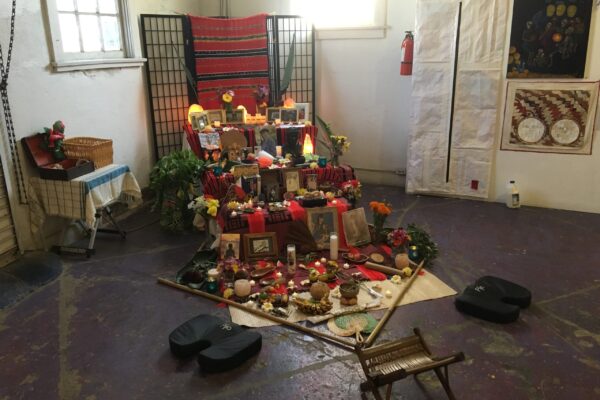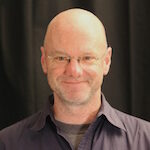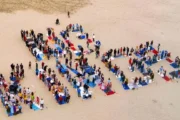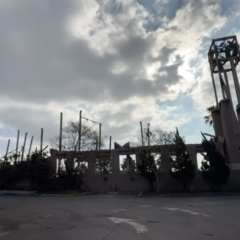Ironically, hope for the Kalinga way of life may be found far from Lubuagan and the Chico River, in the outposts of the Filipino diaspora. For example, one of Cirilo “Sapi” Bawer’s daughters married a U.S. citizen and settled in northern California, where she teaches traditional Kalinga weaving.
When I got back to Los Angeles, I went to an art exhibit in the heart of the largest Filipino community outside the Philippines. Nica Aquino, an artist who’s learning about the indigenous culture of her ancestors in the northern Philippines, sees her retracing of her family’s diasporic journey as part of her own process of self-discovery.
“There’s loads of other younger people around my age who are trying to figure it out, too,” she said. “We’re trying to learn about our culture–recover it, re-learn it.”
At the heart of the Day of the Dead altar curated by Nica Aquino was a picture of Alfonso Gaerlan Aquino, Nica’s recently deceased father. Looking dapper in a suit jacket and stylish cap, Alfonso shared space on the sprawling altar–terraced, like the Igorot farms of the Cordillera–with images of other deceased loved ones and heroes (David Bowie was in the mix). Offerings to the ancestors included candles, flowers, fruit, religious symbols and practical items, like a wicker fan. On the tier below Aquino’s father, next to a picture of someone’s beloved black-and-white cat, Aquino had placed a small flag of the Philippines.
“I’m trying to bring more Filipino programming to northeast LA,” said 30-year-old Aquino, whose Filipino-American Day of the Dead exhibit, which includes original work by other Filipino-American artists, has become an annual feature at Avenue 50 Studio in Highland Park, between downtown and Pasadena.
Highland Park, Eagle Rock and other northeastern LA neighborhoods are Filipino boomtowns. California has the largest Filipino-American population in the US, and Greater Los Angeles–with a Filipino population of more than 600,000–is the largest Filipino community outside the Philippines.
Aquino explained that, while the Day of the Dead is usually associated with the Mexican community, resonances–and syncretisms–between the two cultures add elements to the exhibit that she is eager to explore through her work as an artist.
“I wanted to connect the two because we also celebrate Day of the Dead in our culture,” she said. “But also, in a sense, it’s still related because we’re cultural cousins. You know–same colonizer, same last names, same Catholic religion.”
Aquino–petite, with a Goth-inflected sense of style and finely detailed tattoos on her arms–grew up in LA’s Koreatown. Her parents, who had been together almost 50 years, were both from La Union, a coastal province on the western edge of the Cordillera. Aquino’s father was Catholic, and her mother’s family belongs to an evangelical denomination whose members disapprove of Catholicism.
That tension, and the opportunities presented by a new life in California, inspired her parents to try something that would have been unthinkable for either of them when they were growing up in the Philippines.
“Before I was born, my mom told my dad that she didn’t want to raise me religious,” Aquino said. “And so they never forced me to go to church. The only time I had to go to church was with other family members, because they were still very religious.”
Aquino’s parents took her back to the Philippines to meet her relatives when she was still a baby, then again when she was 4 or 5 years old. Her first time to “go home” as an adult was in 2018.
Then, when her father died, she felt a strong urge to retrace her roots.
“I was like, OK, well, this is why I have savings for emergencies,” she said. “I guess it’s time for me to go back again.”
While she was in San Juan–where her mother has now settled, about 30 miles from Baguio City–a new sort of yearning awakened in her.
“How do you form a spiritual-cultural connection with a place that was very different from the physical place where you grew up?” she wondered. “So, because my parents were so open about me exploring any religion or spirituality, I wanted to explore our pre-colonial practices.”
She added, “I thank my parents for not forcing me to do anything and just giving me the freedom to decide on my own and explore on my own.”
Aquino met with shamans to ask questions about Igorot spiritual practices and struck up email conversations with other artists who were also exploring the indigenous heritage of the northern Philippines.
Soon she realized that she knew more about the pre-colonial culture of the Cordillera than many of the locals she was meeting from “back home.”
While her process of cultural exploration has been very personal, she sees the diasporic search for identity as a communal experience as well.
“There’s loads of other younger people around my age who are trying to figure it out, too,” she said. “We’re trying to learn about our culture–recover it, re-learn it.”
And, like Sapi Bawer, she sees her passion for her pre-colonial heritage as an act of resistance against the global forces of assimilation that produce what Bawer called “robot minds.”
“Some of my relatives back home are always asking me questions about the US and saying that they want to come here. But I am like, look, the American dream is dead. Don’t even think about it, because you’re going to struggle if you go there.”
Just as Aquino is finding a sense of home, many of her peers in the Philippines are eager to uproot themselves from traditions and landscapes that no longer hold their imaginations. Houses are being built along San Juan’s beaches, which used to be undeveloped. The regular Western necessities like electricity and running water are becoming more common.
“They even have Wi-Fi there,” Aquino said.
Indigenous cultural memory and a sense of rootedness in a particular place are among the first casualties of global colonialist movements. Recovering cultural memory and a sense of place is thus often the first priority of those who begin to disentangle their minds from the net of colonizing beliefs. The realization that this process of recovery is a collective endeavor transforms the individual’s idiosyncratic experiment into a broader movement of resistance.
“So many of us that are part of this are first-generation,” Aquino said. “A lot of them are feeling it from their parents–like, what are you doing? I think it’s important to show that there’s a lot of us, that we’re making it work and there’s a space for us.”
Return to “Sapi’s Struggle.”
Nick Street was a senior writer with the USC Center for Religion and Civic Culture.









